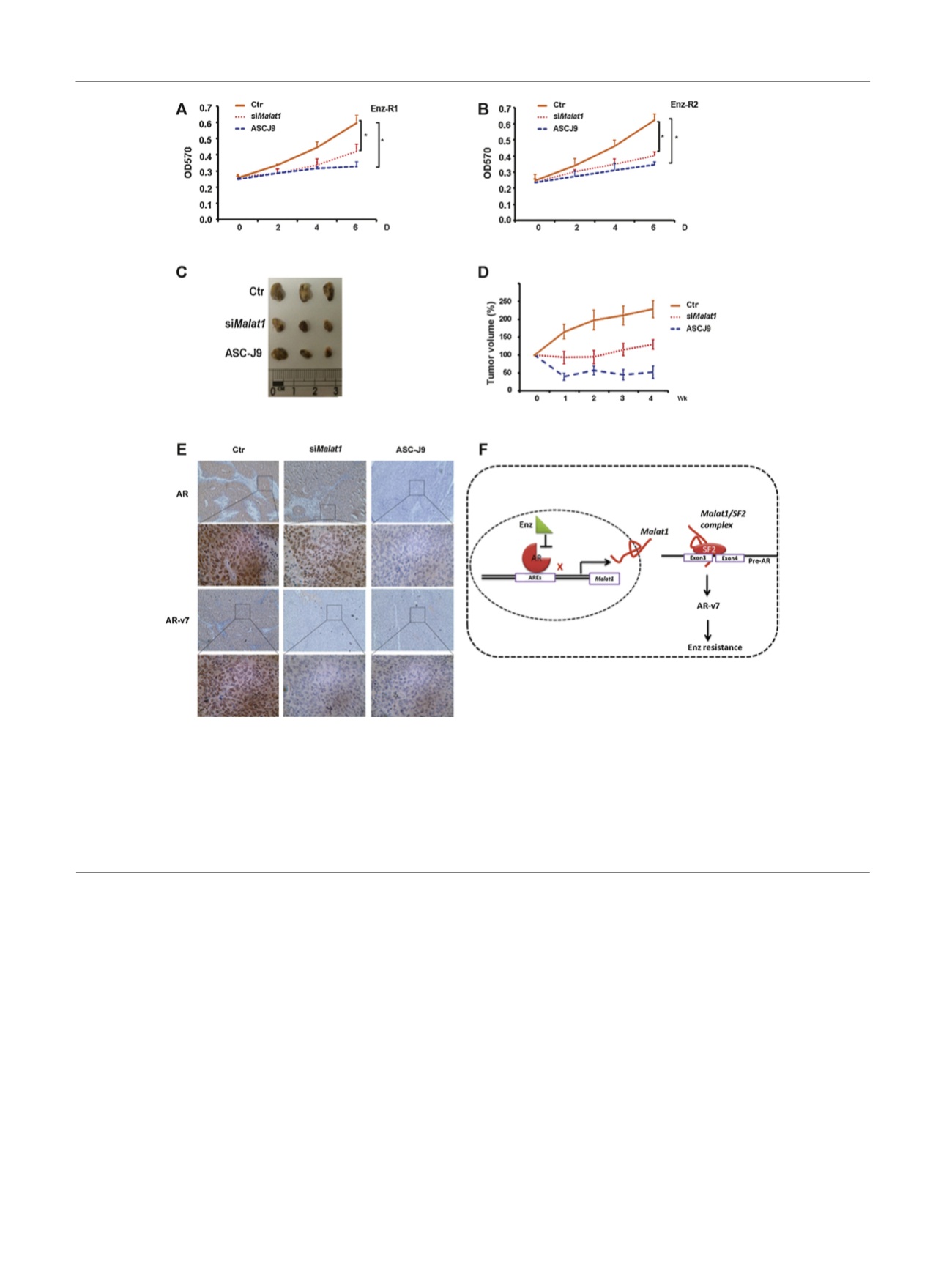

AR-v7. Targeting
Malat1
with siRNA has been effective for
many cancers including PCa, lung cancer, and osteosarcoma
[6,25,26] .However, the efficiency and toxicity of siRNA
delivery remains a major concern for this approach.
Interestingly, bioactive small molecules have been recently
designed to better target RNA based on folding of the RNA
[27] .As a lncRNA,
Malat1
may contain functionally
significant RNA motifs that can be targeted by small
bioactive molecules, and since
Malat1
is highly induced in
EnzR-PCa,
Malat1
expression can be used as a marker in
drug screening to identify molecules that can decrease the
Malat1
expression to provide therapeutic efficacy.
Early studies indicated that treating with Enz could
induce AR-v7 expression in VCaP, but not in LNCaP or C4-2
cells
[8], suggesting that a higher expression of
Malat1
in
VCaP may be required to induce AR-v7 (Supplementary
Fig. 3B), which might be important clinically. It is possible
that the endogenous
Malat1
existing in CRPC before ADT-
Enz may not reach a critical threshold to induce AR-v7
expression and only after induction (via ADT-Enz) may
reach that threshold to induce AR-v7, leading to Enz-
resistance development.
Additionally, we found that AR activity failed to regulate
Malat1
expression in CWR22Rv1 and LNCaP cells (Supple-
mentary Figs. 2A and 2B), suggesting that LNCaP cells may
represent the early stage of PCa that may lack certain
cofactors for
Malat1
induction by AR. However,
Malat1
in
CWR22Rv1 cells may be regulated primarily by AR-v7, thus
are insensitive to treatment with androgen or antiandro-
gens. In a reciprocal manner, AR-v7 expression in
CWR22Rv1 cells is also not sensitive to alterations of
Malat1
expression (Supplementary Fig. 3C), as AR-v7
[(Fig._5)TD$FIG]
Fig. 5 – The
Malat1
-small interfering RNA or anti-androgen receptor splicing variant 7 (AR-v7) with ASC-J9 suppresses enzalutamide-resistant (EnzR)
cell lines in vitro and in vivo growth compared with a control (Ctr). (A) The
Malat1
-small interfering RNA and ASC-J9 (5
m
M) suppresses cell growth of
EnzR1 and (B) EnzR2 cell lines. (C, D) Mouse tumor volumes
[7_TD$DIFF]
(C) were measured (1/2[short axis
2
T
long axis]) and plotted against the control volume of
various treatments and days (D). Tumor dissection of EnzR injected mice with indicated therapies. Control small interfering RNA (
n
= 4),
Malat1
-small
interfering RNA (
n
= 6), and ASC-J9 (
n
= 6) were injected in the periphery of tumors of mice. After 4 wk of weight monitoring, mice were sacrificed.
Representative images
[9_TD$DIFF]
(Rows 1 and 3 are 100
T
magnification and rows 2 and 4 are 400
T
magnification of the boxes in rows 1 and 3) of tumors after
mice were sacrificed
.
(E) Immunohistochemistry staining to monitor AR-v7 and full length AR (AR) expression as indicated with above treatments. (F)
A schematic depiction of molecular mechanism underlying Enz resistance development.
*
p
< 0.01.
E U R O P E A N U R O L O G Y 7 2 ( 2 0 1 7 ) 8 3 5 – 8 4 4
842
















